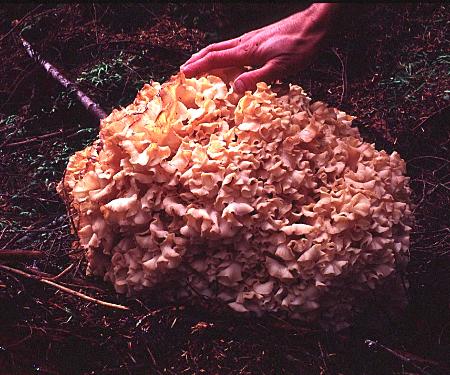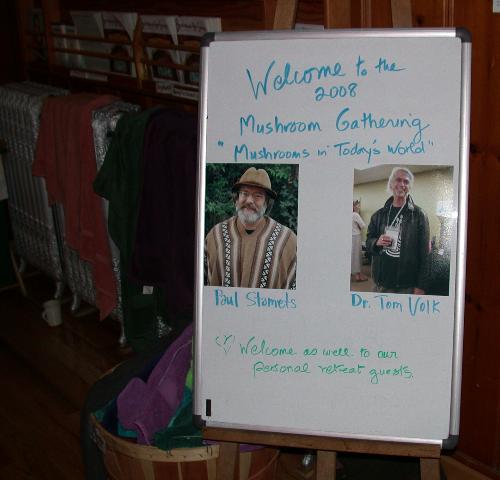Sparassis crispa, the cauliflower mushroom, a.k.a. the noodle mushroom
Tom Volk's Fungus of the Month for October 2008
Please click
TomVolkFungi.net for the rest of Tom Volk's pages on fungi
This month's fungus is Sparassis crispa, a weird, delicious fungus. And it's big! The specimen in the picture to the left is about 1.5 feet wide-- about 45 cm! It is a weak pathogen of conifers, usually infecting the roots. However it is a "good" parasite, allowing its host to live a long and productive life. After all, if a host is giving you free food and nutrients why ruin a good thing? Sparassis crispa appears to be restricted to conifers all through the northern boreal zone and wherever conifers are abundant. It seems to be much more common in western north America. Its close relative, the smaller Sparassis spathulata, seems to be restricted to hardwoods and is more common in eastern North America. There is some complicated taxonomy going on, which you can read about on Mushroom Expert by Michael Kuo.
When I saw my first Sparassis fruiting body, the texture was not quite what I had expected. Maybe expected it to be softer and more like cooked noodles. However, I should have guessed from the "crispa" part of the name what to expect--crispiness! The texture is not quite as crisp as uncooked noodles, but it is kind of brittle as if it were made out of wax. It does soften quite a bit when you cook it.
The flavor is also quite interesting. It's kind of sweet and mushroomy at the same time. I have enjoyed it sautéed in olive oil with a bit of butter or ghee added for flavor. It's really very delicious.
The second time I ever ate S. crispa was at the Mushroom Workshop we used to hold every year in the upper peninsula of Michigan. Some of you will remember this workshop for the fantastic displays of mushrooms in the jack pine plantations. If you were there you would remember the interesting talks about mushrooms from Dana Richter, Heather Hallen, and Gerry Adams. We always had some great workshops about mushroom cultivation from Joe Krawczyk and Mary Ellen Kozak of Field and Forest Products. One year, we found a nice 2 pound specimen of S. crispa under a nearby red pine. We cooked it up and everyone had a taste.
The fact that I can remember every time I found this mushroom says a lot about how special Sparassis crispa is a testament its unique and delicious taste and texture. I hope you enjoyed learning about Sparassis crispa and its relatives. It's a fun mushroom to find and eat. I hope you can find one someday.
Learn more about fungi! Go to Tom Volk's Fungi Home Page --TomVolkFungi.net Return to Tom Volk's Fungus of the month pages listing

 The first time I ever ate this mushrooms was on the Olympic Peninsula in Washington in 1993 when I was working at the Center for Forest Mycology Research in Madison, Wisconsin. During that time I got to travel to collect fungi, and I was once "forced" to visit the Olympic Peninsula in Washington to search for Armillaria nabsnona, honey mushroom number nine. When I went there I got to stay in VIP housing right at the ranger station at the Hoh Rain Forest. I woke one morning to find a herd of Roosevelt Elk grazing outside my cabin. A couple of days after I found A. nabsnona, I was very happy to find my first Sparassis crispa. It was HUGE! -- about 10 pounds (4 kg)! I lugged it back to the camp and cooked it up on the little stove with some butter. It was great!
The first time I ever ate this mushrooms was on the Olympic Peninsula in Washington in 1993 when I was working at the Center for Forest Mycology Research in Madison, Wisconsin. During that time I got to travel to collect fungi, and I was once "forced" to visit the Olympic Peninsula in Washington to search for Armillaria nabsnona, honey mushroom number nine. When I went there I got to stay in VIP housing right at the ranger station at the Hoh Rain Forest. I woke one morning to find a herd of Roosevelt Elk grazing outside my cabin. A couple of days after I found A. nabsnona, I was very happy to find my first Sparassis crispa. It was HUGE! -- about 10 pounds (4 kg)! I lugged it back to the camp and cooked it up on the little stove with some butter. It was great!
 The most recent time I ate this mushroom was at the Breitenbush Mushroom Conference, about an hour south of Portland, Oregon. I have been there twice. The most recent trip was October 2008. My friend Patrice Benson runs the program, and she invited me to come and give some lectures. We found a fantastic number of interesting fungi, especially mycorrhizal fungi. There were so many interesting people there! We also had some very interesting talks by my friend Paul Stamets also.
The most recent time I ate this mushroom was at the Breitenbush Mushroom Conference, about an hour south of Portland, Oregon. I have been there twice. The most recent trip was October 2008. My friend Patrice Benson runs the program, and she invited me to come and give some lectures. We found a fantastic number of interesting fungi, especially mycorrhizal fungi. There were so many interesting people there! We also had some very interesting talks by my friend Paul Stamets also.
If you have anything to add, or if you have corrections, comments, or recommendations for future FotM's (or maybe you'd like to be co-author of a FotM?), please write to me at
This page and other pages are © Copyright 2008 by Thomas J.
Volk, University of Wisconsin-La Crosse.
